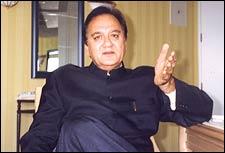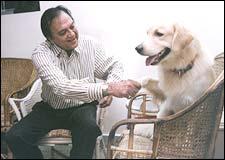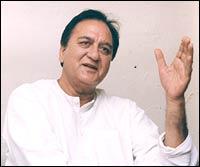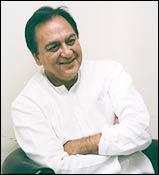I'm sure most of you know Sunil Dutt, yes, the father of Munna Bhai! But what many might not know is that he was born in a village in District Jhelum, Pakistan. While the list of Bollywood actors who trace their roots to present-day Pakistan is long and fascinating, Sunil Dutt is the only one whose exact place of birth I’ve been able to locate.
Sunil Dutt was born on 6 June 1929 in the village of Khurd, District Jhelum. His father passed away before the Partition in 1947, after which his family migrated to India. Initially, they settled in a small village in Ambala district, and later moved to Lucknow. Eventually, he made his way to Bombay, where he pursued a career in films and rose to stardom, particularly with the release of the iconic film Mother India (1957).
He later married Nargis, a legendary actress and a Muslim, with whom he shared a deep bond. Sunil Dutt was not only a successful actor but also a committed social worker and humanitarian, remembered for his tireless efforts to help the poor and promote communal harmony and peace in society.
His connection to Pakistan and Muslims remained strong throughout his life. Perhaps this enduring love and empathy partly explain the hardships his son, Sanjay Dutt faced later in life. But regardless, Sunil Dutt was a man of great heart, vision, and service.
In 1998, he visited Pakistan. And now, instead of telling you the rest of the story myself, I invite you to read it in his own words.
The Rediff Interview / Sunil Dutt
'We all are one, whichever religion we belong to'
May 25, 2005

Actor-politician Sunil Dutt touched many people's lives in his 74 years (he would have been 75 on June 6). And journalist Lata Khubchandani is one of those who remembers Mr Dutt very fondly.
She recalls her last interview with Mr Dutt, just a few weeks before his death. He was in a very reminiscent mood:
I came to Mumbai in my teens. I managed to get a place at Kala Ghoda (south Mumbai) in the Army/Navy building.I shared a room with eight people, which included tailors, barbers, all sorts of people. I studied at the Jaihind College (in south Mumbai) and also worked with BEST (the Bombay Electric and Transport Undertaking).
It used to be very hot those days. We would just leave our room and sleep on the pavement. We used to sleep right outside an Irani restaurant. It used to open at 5.30 am every day -- and that was our wake-up call. As soon as it opened, we would ask for tea. My days started that way, before I left for my early morning classes. It was fun.
We didn't have much money those days. I could afford only the cheapest fare.
 I recall two other restaurants that I used to go to. In Dadar, at Khodadad Circle (northcentral Mumbai), there was another Irani café which we frequented. Then, there was another at Churchgate station (south Mumbai), where we would sit and eat khari (a crunchy, baked biscuit) and chai. Where was the money for anything else?
I recall two other restaurants that I used to go to. In Dadar, at Khodadad Circle (northcentral Mumbai), there was another Irani café which we frequented. Then, there was another at Churchgate station (south Mumbai), where we would sit and eat khari (a crunchy, baked biscuit) and chai. Where was the money for anything else?
It was difficult to live in the Mumbai of the olden days without the Irani cafés. Those were the restaurants we frequented. Today's generation goes to 5-star hotels.
I used to be facinated by the waiters who could carry ten to 12 cups of tea and serve everyone at once. The cups would never fall. Watching this feat was a favourite pastime.
The Irani cafés have contributed to all of us strugglers. Their wonderful tea, their baked items. I recall the breadrolls we used to eat.We would sit in groups and discuss our day's events. Our dreams. Those days hold a lot of pleasurable nostalgia for me.
I remember when I visited my village (in Pakistan) again after 50 years. I was invited by then prime minister Nawaz Sharief. He was very kind when I told him my desire to visit my village. He made all the arrangements for my visit.
My village is called Khurd. It is about 14 miles from Jhelum city, which is on the banks of the Jhelum river.
I have always felt that the people of Pakistan are as affectionate and caring as our own people. You will be surprised (if I told you that) when I went to my village, the entire village gathered to welcome me.
I thought they were doing this because I am an actor and they know me. But it was because they genuinely felt that I belonged there, and that I was coming back for a visit.The village youth gave me a huge welcome with banners, saying, 'Sunil Dutt, welcome to Khurd!' I got a big reception there. All those who studied with me came to meet me. (I met) women who were then 10 years old, (and)were now 60 or 65. My brother's nickname is Soma. They asked about him, my sister Rani and my mother Kulwanti. They remembered all their names. Imagine, after 50 years!
It would be understandable if they did that to me -- am an actor. But my family has not been in the public eye.
For me, it was a really emotional moment. I told them my mother had passed away.
 In Punjab, when someone passes away, women beat their chests. When they heard about my mother, they started beating their chests as if someone from their own family had died. Where would one get more sincere emotion than this?
In Punjab, when someone passes away, women beat their chests. When they heard about my mother, they started beating their chests as if someone from their own family had died. Where would one get more sincere emotion than this?
To think that after 50 years, people forget their relatives. These people gave me so much emotion and sentiment. I was deeply touched.
They took me out to the fields. They told me, "Yeh zameen teri hain (this land is yours], Balla.' My name is Balraj. I was called Balla. I told them, 'No, it belongs to you.' They said, 'Nahin, tum yahan aa jao. Tumhein de denge (No, you come here. We will give it to you).'
All this was not lip service. You could sense their sincerity, their genuineness. I am an actor-director. I can read a face and tell whether the person is genuine or not. There were television channels (present). The villagers were asked why they were giving me so much affection. They replied, 'It is not because of him. It is because of his forefathers who lived here and gave us so much respect. They were fine people and respected our religion. They were landlords. There is a dargah at the outskirts of our village. When they (Dutt's forefathers) neared the dargah, they would alight from their horses, walk on foot till they went past the dargah, and then get back on their horses. They gave us so much respect. Why wouldn't we respect them?'
My father died when I was just five. We lived in the village without any problem. There were more Muslims than Hindus there. During Partition, my entire family was saved by a Muslim. His name was Yakub -- a friend of my father's who lived a mile-and-a-half away from our village. He helped us escape to the main city, Jhelum.
I left Pakistan after I my matriculation.
I never had the chance to visit Lahore. I visited Karachi when I was invited to attend Benazir Bhutto's marriage.
I was very keen that my wife (Nargis, who passed away in May 1981) should also see my village, how we went to school.
 I used to tell her stories about our life there.
I used to tell her stories about our life there.
In Jhelum, I studied at the DAV School. I travelled to school on horseback all through my middle school years, that is from Class V to Class VIII. My school was eight miles away, and there was no other conveyance in those days. Being zamindars, we had many horses. One horse was kept specially for me to go to school. I also remember Rawalpindi, where I studied at DAV School for a year. There was Murree Road, where my school was. Murree is a hill station. It was called Ko Murree. 'Ko' means mountain. Buses plied from Rawalpindi to Murree. Then there was Garden (actually Gordon) College, through which we would walk to get to our school. DAV College was just opposite Garden College, but Garden had this huge complex which we loved. There was this area called Naya Mohalla, where my relatives were. I would live there with them.
Films were taboo for us in those days. We would just look at the posters. My wife was keen to go to Pakistan and see all this. Unfortunately, she couldn't. I really feel this process that has started between our two countries is very positive. Somehow, this hatred should come to an end. I am a believer of nonviolence. I believe we all are one, whichever religion we belong to. I wish it culminates in something positive and we can both grow economically. The money we spend on weapons can be used to give water to the people, to educate everybody, to give them medical aid and to give employment to the youth of the country. If there is no friendship with one's neighbours, no one can progress. Look at Canada and the USA -- both countries help each other.
The above words reveal what kind of man Sunil Dutt truly was. I had the chance to visit his birthplace on 9 April 2014, during the final hours of my vacation in Pakistan. I left my village Lilla (also in District Jhelum) with my cousin Nasir, determined to find the roots of this legendary actor.
Our first stop was Bajwala Kalan (formerly Bajwala Duttan), located at 32°45'26.60" N, 73°30'48.10" E. We discovered that while some Dutt families had indeed lived there before 1947, it was not the Dutt family we were searching for. So, we continued our journey toward Khurd, our real destination.
Sunil Dutt had visited this village in 1998, sixteen years earlier. Surprisingly, many villagers still remembered his visit. A local boy pointed to an old Hindu house and said it belonged to Sunil Dutt. Unfortunately, the house was locked and the current owners were away, which left us disappointed.
Still curious, I knocked on the door of the adjoining house, where we were greeted by an elderly man, Zafarullah Sahib. He gently corrected the boy’s information and directed us to the actual house of Sunil Dutt, located a little further away. He also happened to be a friend of the current owner.
Zafarullah Sahib, over 75 years old, is a refugee from Jalandhar District, who endured the horrors of Partition. He shared that 16 members of his family were killed in 1947. The pain of that tragedy remains etched in his memory. He expressed his bitterness about Partition, and even voiced strong criticisms of Quaid-e-Azam, Liaquat Ali Khan, and Pakistan’s political decisions in later years, including our alliances in foreign wars. Though I responded with some words in defense, I chose not to argue further, out of respect for his age, his loss, and his heartfelt honesty. I could understand, to some extent, the depth of his sorrow and frustration.
Finally, at the house of Sunil Dutt, we were warmly welcomed by the current owner, Yaqoob Sahib, a gentleman in his seventies. His kindness and hospitality were beyond words. We stayed for about 20 minutes, but it felt as though we had known each other for years.
In a strange twist of fate, Yaqoob Sahib’s family migrated from Ambala district.the same district where Sunil Dutt’s family had resettled after leaving Khurd in 1947. Even more remarkably, the man who helped Sunil Dutt’s family during their migration was also named Yaqoob. Some coincidences speak louder than fiction.
This house is located at 32°48'29.20" N, 73°34'31.70" E, a simple home with a powerful story, filled with memories, hospitality, and history.
.jpg)
Yaqoob sahib, the current owner of the house of Sunil Dutt (left) and his friend and neighbour Zafarullah sahib (right), in front of the house. (09.04.2014.)
An old room in the house. (09.04.2014.)
New verandah, but the door is old, the original one. (09.04.2014.)
Another old section of the house. (09.04.2014.)
Courtyard of the house. (09.04.2014.)
Yaqoob sahib, the current owner of the house of Sunil Dutt. (09.04.2014.)
Zafarullah sahib, a resident of Khurd, migrated from Jalandhar in 1947. (09.04.2014.)
View of the house of Sunil Dutt, from the outside. (09.04.2014.)
Yaqoob Sahib told me that they had reconstructed parts of the house a few years ago, but some sections still remained original, just as they were before 1947. As we sat in their home, enjoying cold Seven Up, his son, Israr Ahmad joined us. He kindly offered to show us the ancestral agricultural lands that once belonged to the Dutt family. His family had been allotted 25 acres from those lands after Partition. Israr told us that one of his brothers is an engineer, while he runs a shop in the village.
Ancestral agricultural lands of Sunil Dutt. I was told that a well existed there. But now there is a diesel motor. (09.04.2014.)
Israr Ahmad, Zafarullah sahib and Tariq Amir. (09.04.2014.)
Beautiful view of the fields. (09.04.2014.)
View of Khurd village. (09.04.2014.)
An old pre partition house in Khurd. A Hindu family used to live here. (09.04.2014.)
Another view of the above-mentioned house. (09.04.2014.)
Khurd. (09.04.2014.)
View of a street in Khurd. (09.04.2014.)
Street leading to the village, view from the main Pind Dadan Khan - Jhelum road. (09.04.2014.)
It is very easy to reach Khurd. It is just 20 kilometers away from Jhelum city, on the main Jhelum–Pind Dadan Khan road. It is a prosperous village, with fertile agricultural lands, and a large number of people from this area are working in foreign countries. It was a pleasant experience to visit this village and meeting its wonderful people.
Tariq Amir
June 17, 2014.
Doha - Qatar.
For similar information, visit:

 I recall two other restaurants that I used to go to. In Dadar, at Khodadad Circle (northcentral Mumbai), there was another Irani café which we frequented. Then, there was another at Churchgate station (south Mumbai), where we would sit and eat khari (a crunchy, baked biscuit) and chai. Where was the money for anything else?
I recall two other restaurants that I used to go to. In Dadar, at Khodadad Circle (northcentral Mumbai), there was another Irani café which we frequented. Then, there was another at Churchgate station (south Mumbai), where we would sit and eat khari (a crunchy, baked biscuit) and chai. Where was the money for anything else? In Punjab, when someone passes away, women beat their chests. When they heard about my mother, they started beating their chests as if someone from their own family had died. Where would one get more sincere emotion than this?
In Punjab, when someone passes away, women beat their chests. When they heard about my mother, they started beating their chests as if someone from their own family had died. Where would one get more sincere emotion than this? I used to tell her stories about our life there.
I used to tell her stories about our life there..jpg)











.jpg)
.jpg)
.jpg)
.jpg)
.jpg)
.jpg)
.jpg)
.jpg)
.jpg)
.jpg)
.jpg)
.jpg)
.jpg)
.jpg)
.jpg)
.jpg)
.jpg)
.jpg)
.jpg)
.jpg)
.jpg)
.jpg)
.jpg)
.jpg)
.jpg)
.jpg)
.jpg)
.jpg)
.jpg)
.jpg)





